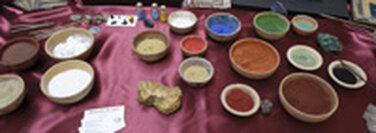In painting buon fresco, a rough underlayer called the arriccio is added to the whole area to be painted, and allowed it to dry for some days. Many artists sketched their compositions on this underlayer, which would never be seen, in a red pigment called sinopia; these drawings are also called sinopia. Later,techniques for transferring paper drawings to the wall
were developed.
 The main lines of the drawing were pricked over with a point, held against the wall, and a bag of soot (spolvero) banged on them on produce black dots along the lines. If a previous fresco was being painted over, the surface would be roughened to give a key. On the day of painting, a thinner, smooth layer of fine plaster, the intonaco, is added to the amount of wall that can be expected to be completed in a day, sometimes matching the contours of the figures or the landscape, but more often just starting from the top of the composition. This area is called the giornata ("day's work"), and the different day stages can usually be seen in a large fresco, by a sort of seam that separates one from the next.
The main lines of the drawing were pricked over with a point, held against the wall, and a bag of soot (spolvero) banged on them on produce black dots along the lines. If a previous fresco was being painted over, the surface would be roughened to give a key. On the day of painting, a thinner, smooth layer of fine plaster, the intonaco, is added to the amount of wall that can be expected to be completed in a day, sometimes matching the contours of the figures or the landscape, but more often just starting from the top of the composition. This area is called the giornata ("day's work"), and the different day stages can usually be seen in a large fresco, by a sort of seam that separates one from the next.
Buon frescoes are difficult to create because of the deadline associated with the drying plaster. Generally, a layer of plaster will require ten to twelve hours to dry; ideally, an artist would begin to paint after one hour and continue until two hours before the drying time—giving seven to nine hours working time. Once a giornata is dried, no more buon fresco can be done, and the unpainted intonaco must be removed with a tool before starting again the next day.
